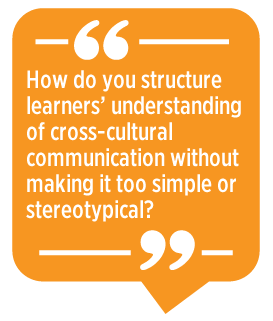|
 Years ago, I found myself in the Guangzhou, China
subsidiary of an international bank, hired to work with department leaders in
developing their English language small talk and relationship-building
communicative skills. Well-prepared with a PowerPoint presentation and language
points I wanted to cover, I faced the following question from the learners:
“How do we communicate across cultures?” That was not a question I was prepared
to answer. Though I had heard of cultural theorists such as Hofstede and Hall,
I had to spend hours on Google in order to pivot toward a more cross-culturally
focused training program—per the learners’ feedback—that I made up as I went
along. Years ago, I found myself in the Guangzhou, China
subsidiary of an international bank, hired to work with department leaders in
developing their English language small talk and relationship-building
communicative skills. Well-prepared with a PowerPoint presentation and language
points I wanted to cover, I faced the following question from the learners:
“How do we communicate across cultures?” That was not a question I was prepared
to answer. Though I had heard of cultural theorists such as Hofstede and Hall,
I had to spend hours on Google in order to pivot toward a more cross-culturally
focused training program—per the learners’ feedback—that I made up as I went
along.
The more I investigated cross-cultural
communication with these professionals, the more I realized that certain tricky
miscommunications did, in fact, seem attributable to culture. I encountered a
fundamental dilemma: How do you structure learners’ understanding of
cross-cultural communication without making it too simple or stereotypical? At
the same time, investigating the myriad permutations of how cultures might
interact would likely overwhelm learners.
The concept of cultural dimensions seemed to be a
good starting point to strike a balance between structure and flexibility in
not only understanding cultures but also in “teaching” cross-cultural
communication to my multilingual learners of English.
Cultural Dimensions Defined
“Cultural dimensions summarize the extent to which
cultural groups are found empirically to differ from one another in terms of
psychological attributes such as values, beliefs, self-construals, personality,
and behaviors” (Smith & Bond, 2020, p. 1). In other words, cultural
dimensions endeavor to elucidate ways in which people of certain cultures think
and act. Though there are several different ways of approaching cultural
dimensions, developed by various theorists, I will focus on the most famous:
The dimensions developed by Hofstede (1980). These include national cultures’
measures of power distance, individualism, and uncertainty avoidance, among
others. To see the dimensions in practice, go to the Hofstede Insights (2023) Country
Comparison tool and type in whichever countries you want to compare.
 On the other hand, the more I learned about
cultural dimensions, the more the criticisms of these dimensions made sense to
me: They homogenized heterogeneous groups, they could be reductionist, and the
surveys upon which they were based were not always rigorously executed. Even
worse, what if someone simply did not follow their cultural dimensions? For
example, if we consider Hofstede’s individualist-collectivist dimension, the
Japanese are supposedly more collectivist than Americans. However, what if
there is an American manager who enjoys discussions to build consensus and
values group harmony? And what if she is interacting with a Japanese IT
professional who prefers to work alone and communicates in short, direct
language? Does that mean that cultural dimensions are useless? On the other hand, the more I learned about
cultural dimensions, the more the criticisms of these dimensions made sense to
me: They homogenized heterogeneous groups, they could be reductionist, and the
surveys upon which they were based were not always rigorously executed. Even
worse, what if someone simply did not follow their cultural dimensions? For
example, if we consider Hofstede’s individualist-collectivist dimension, the
Japanese are supposedly more collectivist than Americans. However, what if
there is an American manager who enjoys discussions to build consensus and
values group harmony? And what if she is interacting with a Japanese IT
professional who prefers to work alone and communicates in short, direct
language? Does that mean that cultural dimensions are useless?
It is this question that I hope to answer in this
article, reconciling the utility of cultural dimensions with a more nuanced
understanding of how cross-cultural communications actually work.
Business English as a Lingua Franca
English in the world today functions on a global
scale as the default lingua franca between speakers of different first
languages, whether in the domain of the internet, industry, trade, or
diplomacy. As such, it is estimated that 70% or more of English communication
worldwide is between nonnative speakers (Rose & Galloway, 2019). Gone
are the days of the British or Americans “owning” English language usage: Now,
these so-called native speakers represent a small minority of lingua franca
communicators worldwide, especially with the increase of English speakers in
places like India and China. Thrust into this global communicative network are
business professionals who need to interact across multiple cultures (including
corporate cultures and subcultures), English varieties, and linguistic
backgrounds.
Contemporary understanding of cross-cultural
communication posits that cultures are not defined static entities; instead,
they are fluid, temporary, and created in interactions—meaning all Americans
are not 10% more individualistic than all Japanese.
Specific to the business context, the degree to which a person or work team or
even corporate culture represents a cultural dimension depends upon the
specific situation and the person(s) with whom they are interacting. (For more
about this, read Baker, 2022, and Davies & Harre, 1990). In other
words, cultural dimensions do not apply to an entire national population;
rather, they are manifested in individual communicative events.
Referring to the earlier example, the collectivist
American manager interacting with the individualistic Japanese IT professional
does not negate the utility of cultural dimensions. Instead, it requires a more
nuanced understanding of how they work based on context and between specific
interactants. In this case, the American is more collectivist than her Japanese
colleague; however, it is also possible that when she interacts with her
company’s sales team, her orientation is more individualistic than theirs, in
which case the dimension is still applicable and useful in understanding the
culture and communication of the sales team, though her relative position
changes.
The question turns to how this understanding of
culture, cross-cultural communication, and cultural dimensions can be addressed
in the classroom.
Principles we have learned so
far:
-
Cultures are not static entities; instead, they
manifest as fluid and are transient during interactions.
-
The position of the interactant in terms of a
particular cultural dimension will change depending on the specific context of
communication and their interlocutor.
Curricular Adaptation and Classroom Implementation
Before discussing possible curricular adaptations
and classroom implementation, it is essential to note that teaching contexts,
stakeholders, and learners’ needs vary widely, so I will present principles and
structures that hopefully allow teachers to make changes that suit their
particular contexts.
 The rationale for leveraging cultural dimensions in
the classroom is that they can help structure students’/speakers’ understanding
of different cultural perspectives and how they interact; however, as stated
previously, it is crucial to understand the dimensions as being applicable in
specific contexts, dependent on the situation and the interactants rather than
as fixed representations of the population of an entire country. With that as a
starting point, more specific classroom implementation becomes
apparent: The rationale for leveraging cultural dimensions in
the classroom is that they can help structure students’/speakers’ understanding
of different cultural perspectives and how they interact; however, as stated
previously, it is crucial to understand the dimensions as being applicable in
specific contexts, dependent on the situation and the interactants rather than
as fixed representations of the population of an entire country. With that as a
starting point, more specific classroom implementation becomes
apparent:
Raise
Awareness
The first step in developing students’
transcultural competence is to expose them to the various concepts that inform
transcultural communication. In this article, I have provided the example of
Hofstede’s (1980) dimensions, though many other significant dimensions could
have been included. Raising students’ awareness of the dimensions should consist
of two basic steps:
-
The dimensions should be presented and defined,
ideally with visual support.
-
The instructor should provide tangible examples
of how the dimensions might manifest (such as the preceding example about the
American manager and the Japanese IT professional).
Reflective
Writing
Reflective writing should also follow two steps:
First, students should reflect on their own cultural dimensions. Again, that
does not mean that their dimensions strictly follow their “national” dimensions
(I put “national” in quotes as this understanding of cultural dimensions
rejects the consideration of cultures as being national); rather, it is a more
profoundly insightful self-reflection regarding how their own cultural
perspectives do or do not match with their supposed “national” dimensions. As
delineated in much literature, home cultural understanding serves as a
foundation for understanding and interacting with other cultures.
The second step would be for the student to
consider a target culture with whom they have to work or interact, or where
they need to travel for work and perform a similar reflection as they did for
the home culture. Experienced professionals can analyze, based on their
experience, where their interlocutors seemed to match with their “national”
dimensions and where they diverged.
Role-Plays
With the preceding foundational work in place,
students can practice transcultural communication through role-plays. The
simplest way to complete this is for students to represent a particular
cultural perspective, forcing their partner to react accordingly. Such
activities could help consolidate students’ understanding of how dimensions
manifest in communication as well as offer them practice in adjusting to the
different dimensions in communicative practice. In other words, the theoretical
understanding would become tangible and practical.
Conclusion
In this article, I have argued that cultural
dimensions have great utility in helping structure students’ and speakers’
transcultural understanding and communicative competence; however, they need to
be understood as fluid, contextually specific, and temporary rather than static
and boundary oriented.
References
Baker, W. (2022). From intercultural to
transcultural communication. Language and Intercultural
Communication, 22(3), 280–293. https://doi.org/10.1080/14708477.2021.2001477
Davies, B., & Harre, R. O. M. (1990).
Positioning: The discursive production of selves. Journal for the
Theory of Social Behaviour, 20(1), 43–63. https://doi.org/10.1111/j.1468-5914.1990.tb00174.x
Hofstede, G. (1980). Culture's
consequences: International differences in work-related values.
Sage.
Hofstede Insights. (2023). Hofstede
Insights. Retrieved March 30, 2023 from
www.hofstede-insights.com
Rose, H., & Galloway, N. (2019). Global Englishes for language teaching. Cambridge
University Press.
Smith, P. B., & Bond, M. H. (2020).
Cultural Dimensions Theory. In V. Zeigler-Hill & T. K. Shackelford
(Eds.), Encyclopedia of Personality and Individual
Differences. Springer. https://doi.org/10.1007/978-3-319-24612-3_2093
Lucas Peltonen is a PhD student at the Hong Kong Polytechnic University. His research focuses on developing the linguacultural competency of business English speakers and learners. With 14 years of teaching experience, Lucas also holds a master’s degree in English teaching from the University of Northern Colorado as well as CELTA, cert-IBET, and TEFL certificates. |